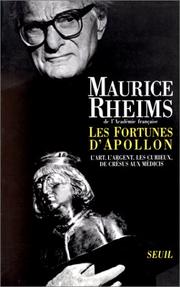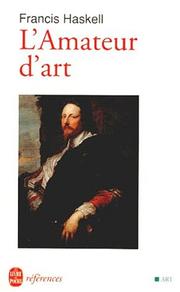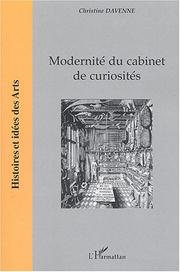| Listing 1 - 10 of 10 |
Sort by
|

ISBN: 2020121026 9782020121026 Year: 1990 Publisher: Paris: Seuil,
Abstract | Keywords | Export | Availability | Bookmark
 Loading...
Loading...Choose an application
- Reference Manager
- EndNote
- RefWorks (Direct export to RefWorks)
Collectors and collecting --- Art --- History. --- Collectors and collecting - History. --- Art - Collectors and collecting - History. --- Objets d'art --- Collectionneurs et collections --- Commerce --- Commande

ISBN: 2253905313 9782253905318 Year: 1997 Volume: 531 Publisher: Paris: Librairie générale française,
Abstract | Keywords | Export | Availability | Bookmark
 Loading...
Loading...Choose an application
- Reference Manager
- EndNote
- RefWorks (Direct export to RefWorks)
Art --- Art museums --- Exhibitions --- History --- Collectors and collecting --- Historiography --- Expositions --- Histoire --- Collectionneurs et collections --- Musées --- Historiographie --- Musées --- History. --- Art - Collectors and collecting - History

ISBN: 2747558606 9782747558600 Year: 2004 Volume: *3 Publisher: Paris: L'Harmattan,
Abstract | Keywords | Export | Availability | Bookmark
 Loading...
Loading...Choose an application
- Reference Manager
- EndNote
- RefWorks (Direct export to RefWorks)
Présentation de l'éditeur Le cabinet de curiosités est dans l'aïr du temps. Des expositions récentes, des émissions radiophoniques le citent. L'ouvrage porte sur la réhabilitation de cette locution. Est-elle le signe d'une sortie des avant-gardes artistiques ou la recherche d'un paradis perdu mêlant les arts et les sciences ? Une histoire des collectionnismes de Verrès à Duchamp est dessinée ici pour comprendre l'outil de clarification, de passage d'un ordre à l'autre que représentent ces dispositifs apparemment désuets. http://www.amazon.fr/exec/obidos/ASIN/2747558606
Collection --- Musée --- Muséographie --- Muséologie --- Renaissance --- Collectors and collecting --- Cabinets of curiosities --- Art objects --- History --- Duchamp, Marcel --- 16e siècle --- 17e siècle --- History. --- Collectors and collecting - Europe - History --- Cabinets of curiosities - History --- Art objects - Collectors and collecting - History
Book
ISBN: 9783110537918 3110537915 Year: 2020 Publisher: Berlin: de Gruyter,
Abstract | Keywords | Export | Availability | Bookmark
 Loading...
Loading...Choose an application
- Reference Manager
- EndNote
- RefWorks (Direct export to RefWorks)
Antiquities --- Collectors and collecting --- Collection and preservation --- Social aspects. --- History of civilization --- essays --- cultural artifacts --- art collections --- Art --- History --- Art, Greek. --- Collectors and collecting. --- Art - Collectors and collecting - History --- Art - Collectors and collecting. --- historiografie van de kunstgeschiedenis
Book
ISBN: 9780262037372 0262037378 9780262344401 0262344408 Year: 2018 Publisher: Cambridge: MIT Press,
Abstract | Keywords | Export | Availability | Bookmark
 Loading...
Loading...Choose an application
- Reference Manager
- EndNote
- RefWorks (Direct export to RefWorks)
Avant les années 1970, les bâtiments étaient généralement considérés comme l’objectif de la pratique architecturale; les dessins architecturaux étaient considérés simplement comme un moyen d'atteindre ce but. Mais, de même que les frontières de l’architecture elle-même se déplaçaient à la fin du XXe siècle, la perception des dessins d’architecture évoluait également; ils ont commencé à être considérés comme des objets autonomes en dehors du processus de construction. Jordan Kauffman, dans Drawing on Architecture, explique comment les dessins architecturaux, promus par un réseau de galeries et de collectionneurs, d'expositions et d'événements, sont devenus des objets d'esthétique et ont finalement acquis le statut d'importants artefacts culturels et historiques Prior to the 1970s, buildings were commonly understood to be the goal of architectural practice; architectural drawings were seen simply as a means to an end. But, just as the boundaries of architecture itself were shifting at the end of the twentieth century, the perception of architectural drawings was also shifting; they began to be seen as autonomous objects outside the process of building. In Drawing on Architecture, Jordan Kauffman offers an account of how architectural drawings--promoted by a network of galleries and collectors, exhibitions and events--emerged as aesthetic objects and ultimately attained status as important cultural and historical artifacts, and how this was both emblematic of changes in architecture and a catalyst for these changes. Kauffman traces moments of critical importance to the evolution of the perception of architectural drawings, beginning with exhibitions that featured architectural drawings displayed in ways that did not elucidate buildings but treated them as meaningful objects in their own right. When architectural drawings were seen as having intrinsic value, they became collectible, and Kauffman chronicles early collectors, galleries, and sales. He discusses three key exhibitions at the Leo Castelli Gallery in New York; other galleries around the world that specialized in architectural drawings; the founding of architecture museums that understood and collected drawings as important cultural and historical artifacts; and the effect of the new significance of architectural drawings on architecture and architectural history. Drawing on interviews with more than forty people directly involved with the events described and on extensive archival research, Kauffman shows how architectural drawings became the driving force in architectural debate in an era of change.
Dessin d'architecture --- Architecture --- Architectural drawing --- Architecture and society --- Collectionneurs et collections --- Aspect social --- Collectors and collecting --- History --- architectural drawings [visual works] --- topical collections --- Technical drawing --- anno 1980-1989 --- anno 1970-1979 --- line drawings [drawings] --- Architecture et société --- Histoire --- Image de l'architecture --- 1945-2000 --- Architectural drawing - Collectors and collecting - History - 20th century --- Architecture and society - History - 20th century
Book
ISSN: 07577486 ISBN: 9782070742370 2070742377 9782072924705 2072924707 9782072982781 2072982782 9782072995705 Year: 2022 Publisher: Paris: Gallimard,
Abstract | Keywords | Export | Availability | Bookmark
 Loading...
Loading...Choose an application
- Reference Manager
- EndNote
- RefWorks (Direct export to RefWorks)
La jaquette indique : "Des accumulations des tombeaux égyptiens ou chinois et des trésors royaux jusqu'à notre Louvre aujourd'hui, entre autres lieux, il faudra du temps pour que le musée trouve sa forme et sa fonction de conservation, d'étude et d'exposition des objets. Or, une histoire mondiale des musées, à la fois politique, sociale et culturelle, n'a encore jamais été écrite. La voici : Le Musée, une histoire mondiale, en trois volumes qui paraîtront sur deux ans. Le premier volume de cette monumentale entreprise, Du trésor au musée, part d'un passé lointain pour arriver à la création de l'institution appelée « musée » inventée en Italie à la fin du XVe siècle, gagnant toute l'Europe au XVIIIe siècle. Une histoire faite de dons et de marchandises, de vols et de pillages, de guerres et de diplomatie. Et aussi d'architecture, de manières de contempler et de manier les objets, de problèmes juridiques et d'organisation. Une histoire d'art, et aussi de commerce, de savoirs et de techniques. Le second volume traitera de L'ancrage européen des musées, de la Révolution française aux années 1850, et le troisième, du musée À la conquête du monde, de la Révolution industrielle à nos jours."
Musées --- Art --- Collectionneurs et collections --- Histoire. --- Collections publiques --- Musées --- Museum --- Collectors and collecting --- Museums --- History --- History. --- Musée --- Museology --- World history --- art [fine art] --- museums [buildings] --- Histoire universelle. --- Musées. --- Muséologie. --- Collectionneurs et collections. --- Collections publiques. --- Museums - History --- Collectors and collecting - History --- art [discipline]
Multi
ISSN: 14778564 Year: 1989 Publisher: Oxford, U.K. : Oxford University Press
Abstract | Keywords | Export | Availability | Bookmark
 Loading...
Loading...Choose an application
- Reference Manager
- EndNote
- RefWorks (Direct export to RefWorks)
The Journal of the History of Collections is dedicated to providing the clearest insight into all aspects of collecting activity. For centuries collecting has been the pursuit of princes and apothecaries, scholars and amateurs alike. Only recently, however, has the study of collections and their collectors become the subject of great multidisciplinary interest. The range of the Journal of the History of Collections embraces the contents of collections, the processes which initiated their formation, and the circumstances of the collectors themselves. As well as publishing original papers, the Journal includes listings of forthcoming events, conferences, and reviews of relevant publications and exhibitions, making it the most comprehensive source available on a subject of increasing interest and study.
Collectors and collecting --- Museums --- Collectibles --- Collectibles. --- Collectors and collecting. --- Museum --- Kunst --- Sammlung --- Angewandte Mathematik --- History --- Acquisitions --- Acquisitions. --- Geschichte --- Collectables --- Memorabilia --- Collecting --- Collection and preservation --- Sammlungen --- Bildende Kunst --- Kunstdenkmal --- Öffentliche Sammlung --- Museen --- Acquisitions (Museums) --- Museum acquisitions --- Souvenirs (Keepsakes) --- Public institutions --- Cabinets of curiosities --- Art --- Hobbyists --- Mathematik --- Künste --- Kunstwerk --- Kulturelle Einrichtung --- Museumskunde --- Musealisierung --- Collection management --- Collectibles - History - Periodicals --- Collectors and collecting - History - Periodicals --- Öffentliche Sammlung --- Künste --- Libraries and Museums. --- Libraries. --- Museum. --- Kunst. --- Angewandte Mathematik.
Book
ISBN: 9789004319745 9789004334830 9004334831 9004319743 Year: 2016 Volume: 1 Publisher: Boston : Brill,
Abstract | Keywords | Export | Availability | Bookmark
 Loading...
Loading...Choose an application
- Reference Manager
- EndNote
- RefWorks (Direct export to RefWorks)
Based on Guilliam Forchondt’s surviving business documentation in Antwerp and applying an aggregate and data-driven approach, Connecting Art Markets focuses on the role of art dealers in mediating the supply and demand for art, behaving in particular ways as to influence the markets for artworks in which they were strategically invested. Van Ginhoven presents her findings on Guilliam Forchondt’s workshop production volumes and transatlantic art trade flows, and evaluates the relationship between the production of paintings in the Southern Netherlands, their local, regional and overseas distribution channels, and the markets for these works in Europe and the Americas during the seventeenth century.
Painting --- History of Antwerp --- collectors --- art market --- Economic relations. Trade --- easel paintings [paintings by form] --- Forchondt, Guillaume --- anno 1600-1699 --- Art dealers --- History --- Oil painting --- Painting, Primitive --- Paintings --- Graphic arts --- Dealers (Retail trade) --- Marketing --- Collectors and collecting --- Forchondt, Guilliam, --- Forchondt, Gilliam, --- Forchondt, Guillam, --- Forchoudt, Guillermo, --- Forchoudt, Willem, --- Art dealers - Belgium - Antwerp - History - 17th century. --- Painting - Marketing - History - 17th century. --- Painting - Collectors and collecting - History - 17th century. --- Forchondt, Guilliam, - 1608-1678. --- collecting, Low countries --- kunsthandel. --- kunstverzamelaar. --- Forchondt, Guilliam. --- 17de eeuw. --- Antwerpen.
Book
ISBN: 9071868737 9789071868733 Year: 2005 Volume: 2 Publisher: Bruxelles: Livre Timperman,
Abstract | Keywords | Export | Availability | Bookmark
 Loading...
Loading...Choose an application
- Reference Manager
- EndNote
- RefWorks (Direct export to RefWorks)
Collectors and collecting --- History --- Collectionneurs --- Verzamelaars --- 7.074 "18" --- 7.032.6/7 --- Kunstverzameling. Activiteiten van verzamelaars--19e eeuw. Periode 1800-1899 --- Kunst van de Klassieke Oudheid --- 7.032.6/7 Kunst van de Klassieke Oudheid --- 7.074 "18" Kunstverzameling. Activiteiten van verzamelaars--19e eeuw. Periode 1800-1899 --- Book history --- anno 1800-1899 --- Belgium --- Great Britain --- Collectionneurs et collections --- History. --- Histoire --- Collectors and collecting - History - 19th century --- Collectors and collecting - Great Britain - History --- Collectors and collecting - Belgium - History --- Conservation. Restoration --- Antiek
Book
ISBN: 9789004262140 9004262148 1306071011 9004262164 9789004262164 Year: 2013 Volume: 227 Publisher: Leiden ; Boston : Brill,
Abstract | Keywords | Export | Availability | Bookmark
 Loading...
Loading...Choose an application
- Reference Manager
- EndNote
- RefWorks (Direct export to RefWorks)
Drawing on case studies from the thirteenth to the twentieth centuries, covering Europe and beyond, Collectors’ Knowledge: What is Kept, What is Discarded investigates how knowledge was acquired, organized and sometimes lost. It examines collections of texts and objects—libraries, textbooks, miscellanies, commonplace books, data collections pertaining to historical events, encyclopedias, royal and ducal treasures, curiosity cabinets, galleries and museums—to uncover the processes of accumulation, organization, selection and rejection that have shaped learning. The essays emphasize the complex relationship between the intentions of collectors and the limitations they encountered—issues of format, presentation, display and storage—as well as outside forces that disrupted their aims, including pillage and natural disasters. Contributors include: Stephen Bann, Laurence Brockliss, François de Capitani, Livia Cárdenas, Steven Conn, Anja-Silvia Goeing, Anthony T. Grafton, Janet Grau, Jürgen Leonhardt, Ulrich Marzolph, Paul Michel, Jürgen Oelkers, Wilhelm Schmidt-Biggemann, Nicola Schneider, Gerald Schwedler, Iolanda Ventura, Monika Wicki, and Marc Winter. Achtzehn europäische und aussereuropäische Fallstudien vom dreizehnten bis zwanzigsten Jahrhundert fragen in “Collectors’ Knowledge: What Is Kept, What Is Discarded – Aufbewahren oder wegwerfen – wie Sammler entscheiden”, wie Wissen erworben und organisiert wurde und weshalb es verloren ging. Die Autoren untersuchen Sammlungen von Texten und Objekten – Bibliotheken, Lehrbücher, Sammelbände, Datensammlungen im Zusammenhang mit historischen Ereignissen, Enzyklopädien, herrschaftliche Schätze, Wunderkammern und Museen. Ihr Ziel ist es, Prozesse der Akkumulation, Organisation, Auswahl und Ablehnung aufzudecken, die unser Wissen über die Epochen geprägt haben. Die Aufsätze unterstreichen die komplexen Beziehungen zwischen den Absichten der Sammler und den Zwängen, mit denen sie konfrontiert waren – in Fragen des Formates, der Präsentation oder Speicherung –, sowie den Kräften, die Verluste bewirkten, beispielsweise Plünderung oder ideengeschichtliche Umwälzungen.
Art: persons --- Collectors and collecting --- Learning and scholarship --- Popular culture --- Art --- Collectionneurs et collections --- Savoir et érudition --- Culture populaire --- Philosophy --- Congresses --- History --- Methodology --- Congresses. --- Philosophie --- Congrès --- Histoire --- Méthodologie --- Collectors and collecting -- History -- Congresses. --- Collectors and collecting -- Philosophy -- Congresses. --- Learning and scholarship -- Methodology -- Congresses. --- Information Science --- Communication --- Archives --- Humanities --- Museums --- Knowledge --- Diffusion of Innovation --- Book Collecting --- General --- Museum Publications --- Savoir et érudition --- Congrès --- Méthodologie --- Collectibles --- Collecting --- Collection and preservation --- Hobbyists --- Erudition --- Scholarship --- Civilization --- Intellectual life --- Education --- Research --- Scholars --- Art, Occidental --- Art, Primitive --- Art, Visual --- Art, Western (Western countries) --- Arts, Fine --- Arts, Visual --- Fine arts --- Iconography --- Occidental art --- Visual arts --- Western art (Western countries) --- Arts --- Aesthetics
| Listing 1 - 10 of 10 |
Sort by
|

 Search
Search Feedback
Feedback About UniCat
About UniCat  Help
Help News
News